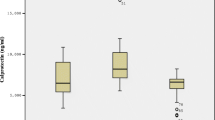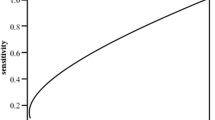Abstract
Calprotectin is an S100 protein and marker of inflammation found in neutrophils and monocytes; S100 proteins are a family of calcium-modulated proteins. The aim of this study was to determine if the serum concentration of calprotectin is higher in patients with laryngeal carcinoma than in patients with benign laryngeal pathologies and controls. The study included 107 participants. The serum calprotectin concentration was analyzed using the calprotectin ELISA (enzyme-linked immunosorbent assay) kit (Calpo AS, Norway). EDTA-serum for analysis was collected prior to surgery from patients with laryngeal carcinoma (n = 41), those with a benign laryngeal pathology (Reinke’s edema, vocal nodules, etc.) (n = 32), and healthy controls (n = 34). The median serum calprotectin concentration was significantly higher in the laryngeal carcinoma group (2179.6 μg L−1) than in the benign laryngeal pathology group (727.84 μg L−1) and control group (733.73 μg L−1) (P < 0.05). The median serum calprotectin concentration in patients with advanced-stage laryngeal cancer (5854.,4 μg L−1) was significantly higher than in those with early-stage laryngeal cancer (971.84 μg L−1) (P < 0.05); however, there was not a significant difference in the median calprotectin concentration between the control and benign laryngeal pathology groups (P > 0.05). Furthermore, the median serum calprotectin concentration in the patients with early-stage laryngeal cancer (n = 21) (971.84 μg L−1) was significantly higher than that in the benign laryngeal pathology and control groups (n = 64) (730.6 μg L−1) (P < 0.05). The serum calprotectin concentration was strongly correlated with poor survival and advanced-stage laryngeal carcinoma. Malignant laryngeal cancer patients (n = 4) that died during follow-up had a higher median serum calprotectin concentration (9468.4 μg L−1) than those that remained alive (n = 37) (857.78 μg L−1) (P < 0.05). The serum calprotectin concentration is higher in patients with laryngeal carcinoma than in those with benign laryngeal pathologies and healthy controls. The present findings show that the serum calprotectin concentration might be used as a marker to discriminate between laryngeal carcinoma and benign laryngeal pathologies. Additional research is needed to further assess the value of this parameter as a useful tumor marker for the diagnosis, treatment, and follow-up of laryngeal carcinoma.

Similar content being viewed by others
References
Hashibe M, Boffetta P, Zaridze D, et al. (2007) Contribution of tobacco and alcohol to the high rates of squamous cell carcinoma of the supraglottis and glottis in Central Europe. Am J Epidemiol 165(7):814–820
Lin HW, Bhattacharyya N (2008) Staging and survival analysis for nonsquamous cell carcinomas of the larynx. Laryngoscope 118(6):1003–1013
Coussens LM, Werb Z (2002) Review Inflammation and cancer. Nature 420(6917):860–867
Gebhardt C, Nement J, Angel P, Hess J (2006) S100A8 and S100A9 in inflammation and cancer. Biochem Phamacol 72:1622–1631
Kristinsson J, Roseth A, Fagerhol MK, Aadland E, Schjonsby H, Bormer OP, et al. (1998) Fecal calprotectin concentration in patients with colorectal carcinoma. Dis Colon Rectum 41:316–321
Strız I, Trebıchavsky I (2004) Calprotectin—a pleoiotropic molecule in acute and chronic ınflammation Physiol Res 53:245–253
El-Rifai W, Moskaluk CA, Abdrabbo MK, Harper J, Yoshida C, Riggins GJ, et al. (2002) Gastric cancers overexpress S100A calcium-binding proteins. Cancer Res 62:6823–6826
Dale I, Brandtzaeg P (1989) Expression of the epithelial L1 antigen as an immunhistochemical marker of squamous cell carcinoma of the lung. Histopathology 14:493–502
Brahian H, Trovik J, Wik E, Stefansson I, Akslen LA, Salvesen HB, Staff AC (2009) Plasma calprotectin concentrations in woman with endometrial carcinoma. Gynecol Oncol 114:491–495
Yui S, Nakatani Y, Mikami M Calprotektin (S100A8/S100A9), an inflammatory protein complex from neutrophils with a broad apoptosis-inducing activity (2003) Biol Pharm Bull 26:753–760
Nagase H, Woessner JF Jr (1999) Matrix metalloproteinase. J Biol Chem 274:21491–21494
Qiu G, Li Y, Liu Z, Wang M, Ge J, Bai X (2014) Clinical value of serum HMGB1 in diagnosis and prognosis of laryngeal squamous cell carcinoma. Med Oncol 31:316
Aria K, Yamada T, Nozawa R (2000) İmmunohistochemical investigation of migration inhibitory factor-related protein (MRP)-14 expression in hepatocellular carcinoma. Med Oncol 17:183–188
Harmani A, Hess J, Servi BD, Medunjanin S, Grobholz R, Trojan L, Angel P, Mayer D(2005) Calcium-Binding proteins S100A8 and S100A9 as novel diagnostic markers in human prostate cancer. Clin Cancer Res 11:5146–5152
Ott HW, Lindner H, Sarg B et al. (2003) Calgranulins in cystic fluids and serum from patients with ovarian carcinomas. Cancer Res 63:7507–7514
Arai K, Teratani T, Kuruto-Niwa R, Yamada T, Nozawa R (2004) S100A9 expression in invasive ductal carcinoma of the breast: S100A9 expression in adenocarcinoma is closely associated with poor tumour differentiation. Eur J Cancer 40:1179–1187
Kristinsson J, Roseth A, Fagerhol MK, et al. (1998) Fecal calprotectin concentration in patients with colorectal carcinoma. Dis Colon Rectum 41:316–321
Odegaard E, Davidson B, Elgaaen BV, Fagerhol MK, Engh V, Onsrud M, et al. (2008) Circulating calprotectin in ovarian carcinomas and borderline tumors of the ovary. Am J Obstet Gynecol 198:418e1–418e7
Acknowledgements
We offer our thanks to Calpro AS, Norway for providing the calprotectin assays.
Author information
Authors and Affiliations
Corresponding author
Ethics declarations
Conflict of interest
The authors declare no conflict of interest.
Funding
None.
Ethical approval
All procedures performed in studies involving human participants were in accordance with the ethical standards of the institutional and/or national research committee and with the 1964 Helsinki Declaration and its later amendments or comparable ethical standards. This article does not contain any studies with human participants or animals performed by any of the authors.
Rights and permissions
About this article
Cite this article
Topuz, M.F., Binnetoglu, A., Yumusakhuylu, A.C. et al. Circulating calprotectin as a biomarker of laryngeal carcinoma. Eur Arch Otorhinolaryngol 274, 2499–2504 (2017). https://doi.org/10.1007/s00405-017-4480-4
Received:
Accepted:
Published:
Issue Date:
DOI: https://doi.org/10.1007/s00405-017-4480-4




